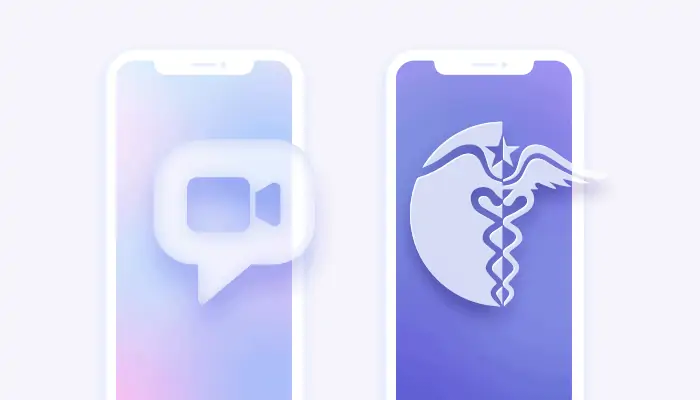
When and why should video conferencing be HIPAA-complaint and why should we care if it isn’t? In most cases, any video conferencing tool is OK if it is secure and reliable. However, when video communication meets the area covered by HIPAA, non-compliance may become a deal-breaker.
HIPAA stands for Health Insurance Portability and Accountability Act, and its name tells us that the area it applies to is healthcare. HIPAA establishes security standards for protecting health-related information. Moreover, it prescribes standards for health information in electronic form – the so-called HIPAA Security Rule.
Today, the healthcare industry stores and manages tons of information electronically. Patients’ records, test results, X-rays, scans, prescriptions, treatment protocols – all these now exist in a digital format.
Having your medical data digitized is awfully convenient – healthcare providers can review the patient’s electronic health record from anywhere in the world, patients can be transferred between clinics and doctors easily, various statistical and analytical algorithms can be applied to detect trends and deviations. At the same time, it is awfully dangerous – digital data can be compromised or stolen in many different ways.
Hence, HIPAA. The Act, among other things, prescribes a clear set of requirements to the software and technologies used in health data management. Meeting these requirements makes the service HIPAA-compliant and, therefore, allowed for use in healthcare applications.
Find out more about: HIPAA Compliant Cloud Hosting: What does it mean?
The rise of the HIPAA video conference
Video conferencing is increasingly widely used in telemedicine as a convenient way of doctor-patient communication. Via video calls, doctors can carry out remote examinations of patients or perform regular checkups of chronic patients without having them spend time visiting the clinic. Both patients and doctors find using video conferences in healthcare very convenient, and the telemedicine market shows steady growth
In 2020, telemedicine received a tremendous boost due to the Covid-19 pandemic. The necessity of social distancing and isolation combined with exponential growth of people needing medical assistance made telemedicine effectively the optimal solution. The authorities were even forced to relax HIPAA restrictions in an effort to satisfy the demand for online technologies in healthcare.
Still, the restrictions are there and will be reimposed in the blink of an eye when the epidemic situation allows so. Therefore, developers of telehealth platforms should create their products with HIPAA in mind to meet its return in complete readiness.
How to choose HIPAA video conference software
The market is full of video conferencing solutions, however, not all of them can be used for healthcare due to not being HIPAA-compliant, even with the Covid-19 measures. For example, Skype in its basic version is not HIPAA-compliant – if you want to use it for healthcare platforms, you need to choose Skype for Business.
The same pattern exists in other video conferencing tools – the free version is often not HIPAA-compliant. You cannot use Zoom for doctor-patient communication, only Zoom for Healthcare.
In these conditions, healthcare providers need to be careful and attentive in choosing the communications service, as it needs to meet the HIPAA requirements for business associates. The good thing is that several video conferencing platform developers have already started implementing HIPAA compliance in the very core of their products.
Find out more about: Top HIPAA Compliant Chat Apps in 2022
What to look for in a video conferencing software to ensure HIPAA compliance
To make sure that you have chosen a HIPAA-compliant video conferencing tool, see that it meets the following requirements:
- Business Associate Agreement. The partnership between healthcare providers (“covered entities”, in HIPAA terms) and communication services (“business associates”) must be in the form of a BAA (“Business Associate Agreement“). The BAA must ensure that the communication or cloud service provider takes the necessary measures to protect personal health information that is stored or transmitted using its resources. For example, a BAA should require that the business associate ensures sufficient system availability and data recovery, describes the data processing formats and established responsibility for violations.
- End-to-end encryption. Under HIPAA, personal patient health information must be transmitted only over end-to-end encrypted channels, meaning that only the terminal devices can decrypt the data. Such encryption protects video call data in transit and at rest. Of course, the safety of encryption keys must be also ensured.
- Peer-to-peer connection. For HIPAA compliance, it is important that the video connection is established directly between the two devices without any intermediate servers. In addition to the compliance matters, peer-to-peer connection improves video call quality and speed.
- Vendor access control. Besides protecting personal patient health information from outside attacks, a HIPAA-compliant video conferencing platform should also ensure its security from inside violations. The communications provider should establish an access and permissions system for its employees with detailed logging, passwords, and monitoring of all access instances. Of course, secure user authentication mechanisms, such as MFA, should be in place, too.
How to ensure HIPAA compliance in a telehealth platform
Of course, you can always build your own video conferencing software making sure that it is fully HIPAA-compliant. However, this may be the most time- and resource-consuming way, as developing a full-featured communication platform for a telemedicine solution is a large project.
Instead, you can consider integrating a third-party communication solution that has been created with HIPAA compliance in mind. For example, check Quickblox that offers a set of SDKs and APIs designed for seamless integration of a comprehensive communication platform into your telemedicine app. They will also sign a Business Associate Agreement. QuickBlox meets the HIPAA requirements by offering several important technical safeguards:
- End-to-end encryption;
- User verification and multi-factor authentication;
- Access control;
- Automatic session termination;
- Data backup;
- Disaster recovery mechanisms;
- Data disposal.
In addition to HIPAA compliance, with QuickBlox you are getting a reliable communication platform that has all the features required in a product designed for use by healthcare organizations and individual healthcare professionals. QuickBlox offers instant messaging, live chat, consistent, high-quality video and audio calls, content sharing – all via secure and protected channels meeting the requirements for telehealth software. Their compliant video conferencing is built on WebRTC and is packed with useful features including screen sharing, file sharing and the ability to record sessions.
For a more finished product, check out Q-Consultation. This QuickBlox ready solution provides a virtual waiting room with video tele-consultation for remote doctor-patient treatment. Features include: chat, voice, and video calling, note-taking, file sharing, patient log-in, user authentication, and patient queue management. Q-Consultation is hosted on a secure, scalable, GDPR, and HIPAA compliant backend.
Find out more about: Doctor-Patient Communication with Q-Consultation
Our engineers will be happy to provide more information and demonstrate how you can integrate a HIPAA-compliant video conferencing tool into your telehealth platform with minimum coding and within the shortest time possible.
Contact us now.



















